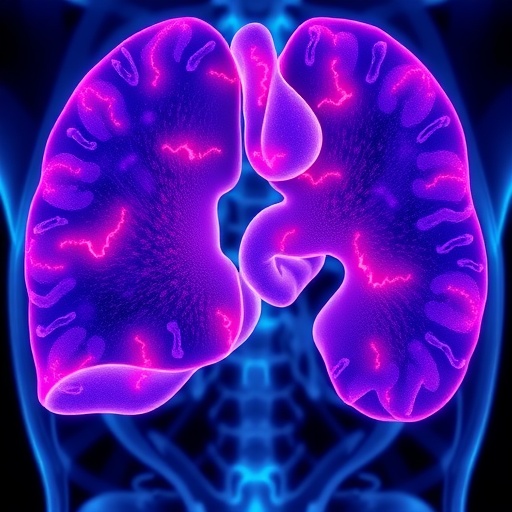
A groundbreaking advancement in the early detection of Alzheimer’s disease has emerged from an international collaboration of researchers affiliated with the German Center for Neurodegenerative Diseases (DZNE), Ulm University Hospital, and University Medicine Halle. Published in the prestigious journal Alzheimer’s & Dementia, this recent study sheds light on the protein beta-synuclein as a promising blood biomarker capable of signaling neuronal damage up to eleven years prior to the manifestation of dementia symptoms in individuals genetically predisposed to autosomal dominant Alzheimer’s disease.
Unlike conventional diagnostic methods, which often identify Alzheimer’s disease only after significant cognitive decline has taken root, this innovative research emphasizes the pre-symptomatic phase of neurodegeneration by focusing on synaptic integrity. Beta-synuclein, a neuronal protein predominantly located at synaptic junctions, emerges into circulation when synapses—the communication nodes between neurons—begin to deteriorate. This synaptic disintegration releases beta-synuclein fragments into the bloodstream, thus providing a quantifiable indicator of early, underlying neuropathology.
The significance of detecting such molecular signposts years before clinical symptoms appear cannot be overstated, especially in light of the recent therapeutic breakthroughs involving amyloid-targeting antibodies. These novel drugs, now increasingly accessible, facilitate the clearance of amyloid-beta plaques from the brain, which are hallmark features of Alzheimer’s pathology. However, their use is contingent upon early diagnosis, an area currently hindered by the lack of sensitive, non-invasive diagnostic tools. As Dr. Patrick Öckl, leader of the Neuroproteomics and Biomarker Research Group at DZNE’s Ulm site, notes, capitalizing on the full potential of these treatments necessitates identification of the disease at its nascency.
The research pivots on data derived from the Dominantly Inherited Alzheimer Network (DIAN), an international consortium dedicated to investigating hereditary forms of Alzheimer’s disease. Unlike sporadic Alzheimer’s, which primarily affects the elderly, autosomal dominant Alzheimer’s manifests early to mid-adulthood, driven by mutations in specific genes inherited with nearly deterministic impact. DIAN’s comprehensive longitudinal data, which includes cognitive assessments, cerebrospinal fluid analyses, and neuroimaging, provides a unique temporal map of disease progression, enabling precise correlation between blood biomarker fluctuations and symptom onset.
In examining over 100 individuals harboring Alzheimer’s-related gene mutations, researchers found that rising beta-synuclein levels surfaced approximately 11 years before expected dementia onset. This timeline precedes gross neurodegeneration, including brain atrophy and amyloid plaque accumulation, positioning beta-synuclein as an early sentinel of synaptic pathology. Furthermore, post-symptomatic elevations in beta-synuclein corresponded with the severity of cognitive deficits, illustrating its dual utility in both preclinical screening and disease monitoring.
The mechanistic basis of beta-synuclein’s role in Alzheimer’s pathology lies in synaptic biology. Synapses constitute specialized structures facilitating neurotransmission; their degradation disrupts neural networks crucial for memory and cognition. Beta-synuclein’s association with synaptic vesicles and its release during synaptic disassembly render it an ideal biomarker reflecting real-time synaptic health. The protein’s quantification from blood samples is technologically feasible via sensitive immunoassays, enhancing its appeal for clinical application.
While the current findings are established within the context of hereditary Alzheimer’s, translational implications for the far more prevalent sporadic form are profound. The pathogenic pathways share many common features, suggesting that beta-synuclein may also serve as an early indicator in non-familial cases. Verification through future studies involving broader populations will be crucial, potentially offering a scalable diagnostic solution to aid early intervention efforts.
Beyond early diagnosis, beta-synuclein measurement opens avenues for therapeutic monitoring. The dynamic changes in its blood concentration could reflect treatment efficacy, particularly in halting or reversing synaptic loss. This capability would dramatically enhance clinical trial design and therapeutic management by providing a quantifiable biomarker to track neurodegenerative progression or arrest in real time.
The integration of beta-synuclein into a multiplex biomarker panel is envisaged as a vital step forward. Alzheimer’s disease, characterized by multifaceted pathology including amyloid deposition, tau tangles, inflammatory processes, and synaptic decay, will likely necessitate a comprehensive diagnostic toolkit. Beta-synuclein’s synaptic specificity complements existing markers, collectively improving predictive accuracy and individualized patient care.
Furthermore, the non-invasive nature of blood-based biomarkers contrasts sharply with the invasiveness of cerebrospinal fluid sampling or the high cost and limited accessibility of advanced neuroimaging techniques. This advantage could democratize early Alzheimer’s diagnostics, facilitating routine screening and monitoring in diverse healthcare settings.
The robust international collaboration underscoring these findings reflects a paradigm shift towards multi-disciplinary, longitudinal approaches to neurodegenerative research. By leveraging state-of-the-art proteomics, neuroimaging, and genetic epidemiology, the research community moves closer to effectuating precision medicine in Alzheimer’s disease.
As the societal impact of Alzheimer’s continues to swell in parallel with aging populations worldwide, innovations such as the beta-synuclein biomarker are essential. They offer hope not only for improved clinical outcomes but also for mitigating the immense emotional, caregiving, and economic burdens associated with dementia.
In conclusion, the identification of beta-synuclein as an early blood marker heralds a transformative step towards timely Alzheimer’s detection and intervention. The capacity to pinpoint disease onset well before cognitive deterioration invites a new era in neurodegenerative disease management, where early treatment may alter disease trajectories and improve quality of life for millions at risk.
Subject of Research: People
Article Title: Early increase of the synaptic blood marker β-synuclein in asymptomatic autosomal dominant Alzheimer’s disease
News Publication Date: 10-Apr-2025
Web References:
https://dx.doi.org/10.1002/alz.70146
Keywords: Alzheimer disease, Biomarkers, Blood, Protein markers, Neuronal synapses, Cognitive disorders
Tags: Alzheimer’s disease genetic predispositionAlzheimer’s pathology and biomarkersamyloid-targeting therapiesbeta-synuclein blood biomarkerCognitive Decline Preventionearly detection of Alzheimer’s diseasehereditary Alzheimer’s diseaseinnovative Alzheimer’s researchneurodegenerative diseases researchneuronal damage indicatorspre-symptomatic Alzheimer’s diagnosissynaptic integrity and neurodegeneration





